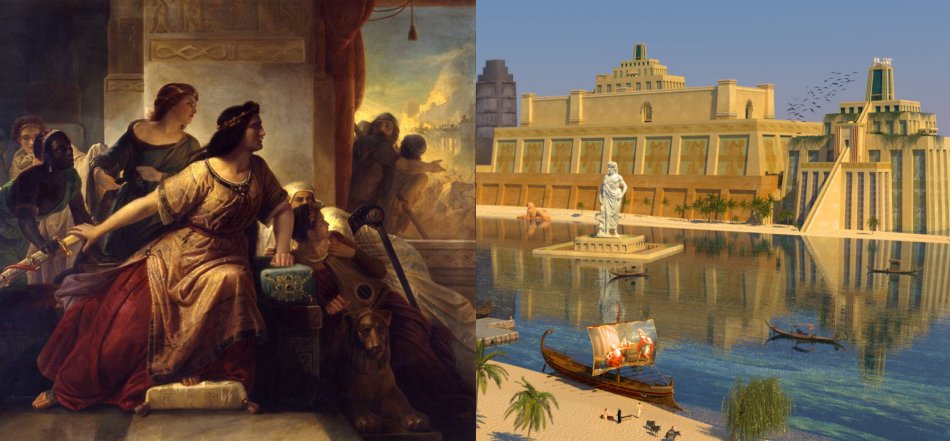Part Two:
Naqia also like
Adad-guppi, Nabonidus’ mother
by
Damien F. Mackey
“In addition to telling us a little
of Semiramis, Herodotus narrates
a story of a
Babylonian queen called Nitocris. While some have identified this legendary figure with Zakutu
(Naqia), the wife of Sennacherib and mother of Esarhaddon,
others have proposed Adad-guppi,
the mother of Nabonidus”.
Cambridge Ancient History
That Queen Naqia
of Assyria, mother of Esarhaddon (c. 681-669 BC, conventional dating), invites strong
comparisons with the legendary Queen Semiramis, has been noted by scholars. And
I have discussed some of these perceived likenesses in Part One:
drawing upon
examples to be found in, for instance, Dr. Stephanie Dalley’s tremendous book, The Mystery of
the Hanging Garden of Babylon (2013).
For example, Dr.
Dalley writes:
Here, then, we have a group of
material that indicates attachment of Naqia’s deeds to the name ‘Semiramis’. As
second wife of Sennacherib, she bears comparison with the historical
Sammu-ramat for having her name on inscriptions written during her lifetime,
and for supporting publicly first her husband and then her own son, both as
kings.
There was every reason,
therefore, to conflate the two great queens, two great builders, Naqia would be
the wife of the later Assyrian king to whom Diodorus referred when he wrote:
‘the Hanging Garden, as it is called, which was built, not by Semiramis, but by
a later Syrian [a Greek reference to Assyrian: Dalley] king …’ His account that
‘Semiramis alongside a Ninus founded ‘Babylon’ on the Euphrates gives details
that are applicable to Nineveh: two palaces, technical details of water supply,
walls adorned with hunting scenes. ….
[End of quote]
It becomes
apparent from Dr. Dalley’s book that some Assyrian advancements and technology
were wrongly attributed later (by e.g. the Greco-Romans) to Babylonia -
Sennacherib of Assyria commonly being confused by them with Nebuchednezzar.
That is
understandable to some extent if I am correct in my proposed collapsing of late
neo-Assyria into early neo-Babylonia, and actually identifying Sennacherib of
Assyria’s successor, Esarhaddon, with Nebuchednezzar. See e.g. my article:
Esarhaddon a tolerable fit for King
Nebuchednezzar
The
Cambridge Ancient History (Vol. III, pt. 1, 1982, pp. 243-244) tells, in
regard to Nitocris, of scholars being unable to determine if she were meant to
represent Naqia or Adad-guppi:
Related to
this discussion is the matter of legends about Assyrian and Babylonian
individuals which has been preserved in other languages and literatures, in particular the tales told of Semiramis, Nitocris, and Ahiqar. Legends about Semiramis are found in Greece, Armenia, and Persia but
the best-known version is that of Ctesias, as preserved in Diodorus. Since
the early days of Assyriology it has been widely accepted that the heroine of
the tale should be identified with the historical
Sammuramat, wife of Shamshi-Adad V and mother of Adad-nirari III …. In addition to telling us a little
of Semiramis, Herodotus narrates
a story of a Babylonian queen called
Nitocris. While some have
identified this legendary figure with Zakutu (Naqia), the wife
of Sennacherib and mother of Esarhaddon, others have proposed Adad-guppi,
the mother of Nabonidus.
[End of
quote]
Similarly,
Matt Waters in Ctesias’ “Persica” in Its Near Eastern Context (p. 46) ‘ties up’ altogether Semiramis, Naqia and Adad-guppi:
Semiramis’ legends as preserved in
Greek traditions have been traced through prominent Assyrian and Babylonian
women such as Naqia (also called “Zakutu”), the wife of Sennacherib (r. 705-681)
and mother of Esarhaddon (r. 681-669), as well as Nabonidus’ mother,
Adad-guppi.
Naqia
may herself, in fact, have been a Babylonian: “Naqia was probably born in Babylonia,
but her family may have originated in the Harran area”:
That queen
Naqia and Adad-guppi would be alike comes as no surprise to me, given that I
have already identified Naqia’s son, Esarhaddon (= Nebuchednezzar) with
Adad-guppi’s son, Nabonidus (= Nebuchednezzar). See e.g. my article:
Aligning Neo-Babylonia
with Book of Daniel. Part Two: Merging late neo-Assyrians with Chaldeans
Nor would it be surprising if Naqia’s
“family may have originated in the Harran area”,
given
Adad-guppi’s close association with Harran – some
think she was born there: “Adad-guppi
Princess of Assyria. Date, Place, Source. Born : -, b. 649 BC in Harran”: http://www.american-pictures.com/genealogy/persons/per01964.htm
“Adad-guppi, was an Assyrian priestess, a devotee of the moon god Sîn in the northern Assyrian city of Harran”: https://en.wikipedia.org/wiki/Addagoppe_of_Harran
